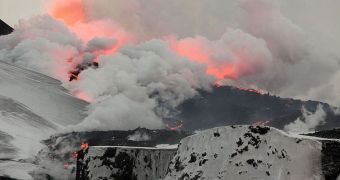The glaciovolcano Eyjafjallajokull erupted on March 20 for the first time in two centuries, covering the skies above Iceland, and indeed most of Europe, with a thick cloud of ash. This prevented airplanes from taking off, and cased significant damage to the European economy. As such, it stands to reason that people are very interested to know when all this will end. However, geologists and volcanologists steer clear of establishing time frames, saying that there is no possible way to predict such information
“For most volcanoes, they have a single magma chamber that just deflates. This volcano is more complicated. We're seeing magma transfer from other chambers, and we don't know how large the magma reservoir is. We cannot estimate how much longer it will last,” told LiveScience Freysteinn Sigmundsson, who is a geophysicist at the University of Iceland and an expert on this type of volcanoes. According to preliminary estimates on the intensity and scale of the Iceland eruption, it could be that the glaciovolcano will continue to spew out varied amounts of lava and ash for as long as a year. In either case, there is a small chance that the eruption will stop within the next six months.
The thing about the Eyjafjallajokull volcano is that it does not keep a steady tempo as it goes. In other words, it went from being a benign threat to rumbling, and then detonating without warning. It then reduced the intensity of its activity again, only to burst up again a few weeks later. “Hawaii's been erupting for 23 year years, and it’s a similar kind of volcano. No one really knows how much longer this will last,” says United States Geological Survey (USGS) Volcano Hazards Program associate program coordinator William Burton, quoted by Life's Little Mysteries.
In the past, the Iceland volcano behaved in very much the same way as it does today. For example, during its 1821 eruption, Eyjafjallajokull managed to cycle between a drooling-magma state and a very violent one for more than a year, before it finally settled down. The thing about this particular volcano is that it is placed directly above the mid-Atlantic oceanic ridge, which is an area where tectonic plates move away from each other, giving birth to new landmass.

 14 DAY TRIAL //
14 DAY TRIAL //